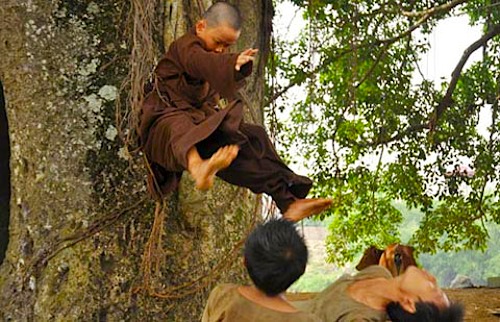By Joe Bendel. It is probably safe to argue the first emperor of the Later Lý Dynasty was considerable better than his predecessor, the last king of the Anterior Lê Dynasty. The latter was only the third of a short line, who had killed the second, his brother, soon after he ascended to throne. The future emperor Ly Cong Uan witnessed all that chaos and oppression first hand, learning lessons in governance to establish a new dynasty that would last for two centuries. Ly’s rise from humble roots to the heights of royal power are chronicled in Luu Trong Ninh’s The Prince and the Pagoda Boy, which screens during the 2015 edition of New Vietnamese Cinema at the Honolulu Museum of Art.
Little is known of Ly’s mother, but it is an established fact he was raised in a pagoda as a Buddhist disciple. As a result, young Ly had mad skills that he used to defend the village children from bullies. Recognizing Ly just is not ready for enlightenment yet, his master transfers him into the king’s service. The new officer cuts quite the imposing figure, so Le Long Dinh, one of three ambitious princes vying to succeed their father, makes a point of befriending him.
However, Ly still has the same sense of righteous justice, causing friction with the prince, especially after he kills his freshly crowned older brother to claim the throne for himself. Nevertheless, Ly agrees to return to Le’s service to help unify the nation and establish security for the peasantry. Of course, their new understanding will only last so long, given Le’s duplicitous nature and Ly’s ethical principles. To top it all off, they are both attracted to the same woman.
You probably shouldn’t swear by the historical details in Pagoda. Some liberties might have been taken, especially with respects to Ly’s hardscrabble origins, but they make for a big sweeping Horatio Alger epic. However, the film will have plenty of credibility with martial arts fans thanks to the involvement of action star Johnny Tri Nguyen as the fight coordinator. There are some great battle scenes, but it is tough to top young (ten-ish) Ly laying a beatdown on a trio of thuggish twelve year olds (who surely walked away from the film with only minor bruising. After all Nguyen co-starred in Power Kids, so he must have picked up plenty of child safety tips there).

Quách Ngoc Ngoan is also a pretty convincing action star and dignified enough to be a future emperor. His size, athleticism, and a speak-softly-but-carry-a-big-stick presence have the potential to breakout with international fans if they see enough of him. Alas, that could be the tricky part (as it has been for Nguyen), considering Pagoda was released in 2010 to celebrate the millennial of Ly’s founding of Hanoi as the new Capitol city.
Likewise, the young actor playing Ly while still a Pagoda Boy has tremendous moves and similarly impressive screen charisma. Understanding the demands of villainy, Vu Dinh Toán’s prince aptly chews the scenery and preens like a peacock, embodying the absolute antithesis of the ramrod-straight Ly.
Frankly, it is strange that Pagoda has not been more widely seen on the festival circuit. Cinematographer Dominic Pereira has an eye for spectacle and Nguyen coaches a game cast through some satisfyingly cinematic combat. It is a really strong fusion of prestige historical drama with crowd pleasing action. Highly recommended for martial arts fans, The Prince and the Pagoda Boy screened this past Wednesday (7/8) and Thursday (7/9), as part of New Vietnamese Cinema 2015 at the Honolulu Art Museum.
LFM GRADE: A
Posted on July 9th, 2015 at 11:33pm.